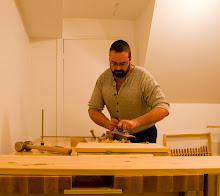I start with mineral spirits to wipe the piece down with. As I will get into later, I should have spent more time wiping the piece down. Or at least, I should have paid more attention when I was wiping the piece down. If there are problems that show up when you wipe on the mineral spirits then deal with them now rather than later. After wiping down the piece with mineral spirits I add boiled linseed oil to the mineral spirits left in the container. I want a rich mixture (more oil than mineral spirits) because in this case I added a good, solid slurp of wood stain, and since the stain is thin it will replace some of the mineral spirits. As long as the stain is not water-based it will mix right in. I just grabbed the darkest stain that I had and dumped some in. I ended up with some dark finish reviver as seen below:
 I then used a clean rag to generously apply the oil mixture to the table. I have a piece of hardboard protecting my bench from drips and whatnot, because I want to be able to slop this stuff on with gay abandon. Get it in all the nooks and crannies. I saved the left-over reviver in a jam jar because after it dries I'll be looking for spots on the table that didn't get dark enough.
I then used a clean rag to generously apply the oil mixture to the table. I have a piece of hardboard protecting my bench from drips and whatnot, because I want to be able to slop this stuff on with gay abandon. Get it in all the nooks and crannies. I saved the left-over reviver in a jam jar because after it dries I'll be looking for spots on the table that didn't get dark enough.I've already noticed an area that I should have spotted while I was wiping the piece down with mineral spirits - a spot of adhesive of some sort. If I had noticed it in time then I could have saved myself some grief. As it is I'll have to strip that spot, then remove the adhesive, then apply the oil again, and wipe it down again. Ah well. Here's the table as it stands right now. I didn't oil the top because I'm going to refinish the top completely - it's too badly damaged and needs to be scraped.
 Here's the table with the oil mixture slopped on. I had it upside down for convenience, and I used a corner of the rag to push the oil mixture into the 'decorative grooving'. After the 10 or 15 minutes, I'll wipe off the excess, and...
Here's the table with the oil mixture slopped on. I had it upside down for convenience, and I used a corner of the rag to push the oil mixture into the 'decorative grooving'. After the 10 or 15 minutes, I'll wipe off the excess, and... Here it is. It's looking a LOT better. The vast majority of the problems that it had have been sufficiently camouflaged by the oil mixture. Some of the really big chips need a bit more colour, and I'll get to that in a future posting. Right now I have to wait for this thing to dry over night.
Here it is. It's looking a LOT better. The vast majority of the problems that it had have been sufficiently camouflaged by the oil mixture. Some of the really big chips need a bit more colour, and I'll get to that in a future posting. Right now I have to wait for this thing to dry over night.A hint I'd like to pass along is to also pay attention when you're wiping the extra oil off. It's not that hard to miss a spot, and you don't want that, because the oil will take forever to dry when it's that thick, and it will dry with a dimpled orange-peel finish. If you catch it after a day and try to wipe it off then it will be sticky and it will grab the cloth and things will be unpleasant. Use a rag damp with mineral spirits to sort the problem out, then you'll have to wait for it to dry again.
Oh, and don't leave rags wet with linseed oil piled up in a garbage can. Although it's quite rare it's possible for oily rags to spontaneously combust, and linseed oil is famous for that. Leave the rags spread out on the bench and they will dry over night. Once the rags are dry they can be safely thrown in a garbage can.

No comments:
Post a Comment